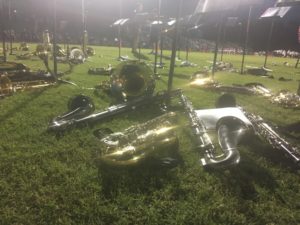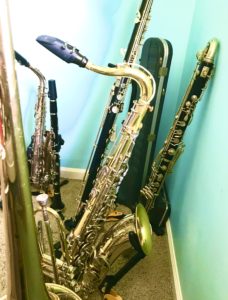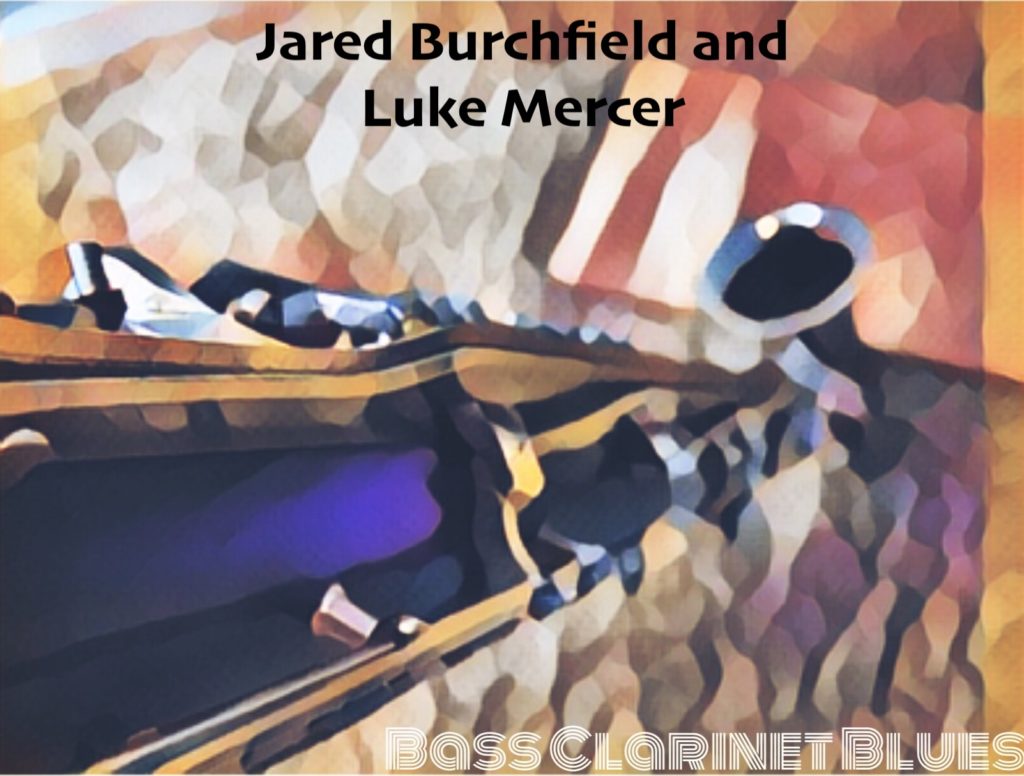This is where you can listen to music which I record and produce myself, and read about my inspiration behind them. You may listen by clicking the link that corresponds with the album you want to hear, which will take you to the associated DistroKid page. All original music Copyright (C) 2018-2024 Jared Burchfield Music. You can also find these albums on any major music streaming service or online store. Thank you so much for listening to my music!

Bass Blues and Other Old Tunes (2022)
https://distrokid.com/hyperfollow/jaredburchfieldmusic/bass-blues-and-other-old-tunes-2
This is a very special album release for me, and I figured since I am about to graduate, this would be a good time to release this sort of legacy album. It is a collection of songs that I have worked on and wrote over the years from about 2016-2019 which have been rewritten and recorded multiple times. Many of these songs come from a previously unreleased album called “Bass Blues” which would have been considered my first actual album. My goal as a self-proclaimed “jazz bass clarinetist” was to prove to the world that bass clarinet was more than just a band/orchestral support instrument but had a unique solo voice that could and should be shared with the world in any style of music. In many ways I can consider this album a journey back in time through my musical development to about 2016 when work on these songs first started. In those days, I thought of music a lot differently. Music was more simplistic and more mysterious to me, and I had this mentality of just making music that sounded good and was fun to play. I didn’t worry about sounding like anyone else or following any composition rules, nor did I care to understand any of that. I just used musical motifs and ideas that sounded good to me and wrote songs based on them. This yielded various results, but at its best I ended up with many of the songs that you will hear on this album. I wasn’t concerned with proper theory and complicated chord progressions or any of that; I just wanted to make music. And believe it or not, I consider some of this some of my best and most genuine music, and here is my reasoning. My thoughts when I sat down to make music back then were about expressing myself and having fun with the musical experience, which is something that I felt like I lost later on in life.
After going into music college, I felt like I was always pressured to “fit the mold” and make my music fit a specific genre. I was so concerned with proper voice leading and theory rules and trying to conform my melodies to the “standard” chord progressions. There were many songs that I wrote that were an attempt and sounding like another artist or trying to be complicated when it was not necessary. While these songs were good, I didn’t feel like they were truly my work. I felt like I was loosing myself and the ability to express myself because I was trying to be the musician that other people expected me to be rather than the musician I wanted to be. No longer could I be a jazz bass clarinetist, I had to be a classical clarinetist or a jazz saxophonist. Now don’t get me wrong, both of those things are a lot of fun and I learned so much from doing those things, but neither of those were really me. I am really a bass clarinetist who just happens to play clarinet and saxophone. Working on this album really helped me to rediscover myself in my music and helped me to understand that it is good to do your own thing. This album is supposed to be more individual and will be kind of different in some ways from my other stuff I have released recently.
You will hear some basic chord voicings and progressions and repetitive melodies, which may lead some to criticize and call it “too simple” or “harmonically boring” but the important thing here is the expression of emotion in the music, not the over complication of something that doesn’t need it. If we all made the same music the exact same way, none of it would be special. And yet that is what so many people seem to push upon us. They impress this idea on us that we always have fit the stereotypes of our instruments. We are told that we must be “traditionally correct” or have to sound and model ourselves after a specific artist or we are not “real musicians” which is a terrible and false message. Music is an emotional thing that is different for everyone and we have the right to interpret it and make it whatever we want it to be. And that is what makes music so beautiful.
This is kind of what I am trying to get at with this album, as well as share some of my old tunes with you all. Fun fact: the tracks “The Bass Meets The Blues” and “Suspense and Sorrows” are original unedited recordings of me playing bass clarinet in 2017 in high school. Also, I use the term legacy to describe my musical journey but this is not the end of my music production whatsoever, as I have several albums planned for the future that I will work on outside my continued education. With all of that being said, enjoy the music!

A New Season (2022)
https://distrokid.com/hyperfollow/jaredburchfieldmusic/a-new-season
I just uploaded my newest album “A New Season” and it will be appearing in stores soon! Like many of my other releases, this album features a lot of different styles of music and a number of inspirations. This album kind of tells a story about this past year in my life, but more than that it was just a lot of fun to produce. This features 3 songs that were recorded on an Apple eMac G4 which was fun to produce with. It incorporates a number of different instruments, and marks the first recording with flute for me, which is in the background of “The Fondness of Heart.” I also use the Yamaha Portasound keyboards a few times on this album as well as a Buffet E11 Clarinet in A on “Come Back To Me”, which is an instrument that is mostly used in orchestra and doesn’t really appear in jazz; but any instrument can be a jazz instrument if the player wants it to be. I also used a very rare Bundy Mazzeo Model Clarinet on “Bossa Nova Clarinet” and “Childhood Memories.” Of course the Kohlert and the Buffet 1193 from my school held down the bass clarinet work on this album, and the Yamaha YTS-23 on the tenor sax stuff. One other thing is that this album marks the last album that has my schools Selmer Mark VI Bari Sax, as I had to return it this past semester and that was very sad, so enjoy its beautiful low notes one more time.
This album represents the roller coaster of emotions that I experienced this semester, both the good times and the not so good, and a longing for the way things were and a looking back to the past. It also represents a future of teaching music and playing music and expression though new and different styles of music, while not abandoning the old things that I have always had in my music. My goal is to incorporate other styles into my music and be inspired by other musicians, but not become a clone who sounds like and plays like everyone else. Music is expressive and individual and we as musicians should have the right to freely play and write the way we want without having someone tell us that our style is wrong or bad or “traditionally incorrect.” Music is an expression of ones self, and that means different things for different people. There is no such thing as a right or wrong way to play music. ” Take the traditional principles and twist them to make your own style, music is an art after all!
You may notice that of the instruments I list that I used, only one of them is a “professional model” instrument. That was intentional. Most of the horns I own are “student model” instruments and I use them quite a bit. In fact, very note you hear played by a clarinet or a tenor sax on this album was played on some old student model instrument and all of the Bb clarinets used were plastic. I do this on purpose to prove that equipment doesn’t make you a good musician. I enjoy using instruments and equipment that are seen in most people’s eyes as useless or are considered to be not standard, and taking it and doing something really cool with it. Sure it takes more work, and of course people are critical of it, but it’s worth it to make something really unique and special. To add to that, this whole album was produced on a 2008 Mac Pro and a 2004 eMac G4 using Garageband from the iLife 11 and 06 suites respectively. Again, this was done intentionally to prove that you can make good music that people can enjoy on equipment that is not the industry standard. There is so much more to music than what brand or model of instrument you play or what recording equipment you use, and its your right as a musician to make those decisions for yourself. Play what you works best for you and enjoy making music, and don’t let anyone tell you otherwise. With all of the inspiration stuff out of the way, I hope you can enjoy this album!

Diminished Tuesday (2021)
This album is my longest album so far with 10 tracks and has been a very big project. It features me messing around with several new styles including samba, reggae, and bossa nova, as well as some more classic jazz and blues tunes. It also seeks to include other instruments in solo roles besides just bass clarinet. I also tried to include more keyboard improvisation solos instead of just horn solos. I hope you can hear an improvement in my saxophone playing as well as my improvisation skills from previous albums. The track “Tybee Samba” was inspired heavily by the work of the saxophonist Stan Getz, particularly from his Jazz Samba album with Charlie Byrd. Getz is one of my favorite saxophonists and I like to learn his tunes in my own practicing. “Tybee Samba” undoubtedly pulls elements from his playing, particularly the songs “O Pato” and “Samab Deez Days.” This was not an attempt to copy Getz, but rather an attempt at writing a tune based on his excellent work. The tracks “The Cry of Garland” and “Relaxing On The Shore” are completely based of repeated figures that originated from the beeps from machinery that we use in the restaurant that I work in part time. Incorporating these elements into these tunes always reminds me of those nights working in this restaurant whenever I listen to it and most of my friends who work with me there will likely be able to pick out these elements in these songs. With all of that said, I hope you enjoy the music!

Listen to Rampage the Studio Volume 1
Rampage the Studio Volume 1 Album Info
This album features my friend Luke Mercer, who is a great musician, photographer and film creator. He played keys and drums on all of the songs, and he composed many of the melodies heard in the songs on this album. This album is Volume 1 of our songs, and there will be a Volume 2 released later on. These songs span from 2016 to 2020 and are mostly Luke and I playing a head together and then taking solos over various improvised chord progressions. This album is mainly bass clarinet and clarinet solos, with a few saxophone backgrounds. Volume 2 will feature more saxophone solos. Special thanks to Luke Mercer and his family for their support, and to OneStrum Media for allowing us to use their equipment. The instruments used on this album are a 1930’s Kohlert and Sons Bass Clarinet, a Selmer Model 67 Low C Bass Clarinet, a 1971 Selmer Mark VI Baritone Sax, a Yamaha YTS-23 Tenor Sax, and a Evette Buffet Crampon Plastic Bb Clarinet. The album was created in Logic Pro X and Pro Tools.

Exit 27 Album Info
I began working on this album in 2018. It is a compilation of songs that I wrote throughout high school and it serves as a tribute to the impact that my high school band had on me as a musician and as a person. This album also attempts to use the bass clarinet as a solo instrument in a more jazzy/bluesy way as opposed to the typical orchestral solos that bass clarinets are commonly associated with. The album features the bass clarinet in many different styles of music, none of which the bass clarinet normally appears in. It seeks to prove that the bass clarinet is a viable solo instrument in jazz and other types of music, and can fit in well with other instruments that are more typical of these musical styles. I used a 1920’s Kohlert and Sons Kraslice bass clarinet and a 1970’s Selmer/Bundy 1430P bass clarinet to record the bass clarinet solo and accompany parts with a Yamaha 4C Mouthpiece, Rovner Ligature, and Rico 3.5 Reeds. I also used a King Cleveland 613 Alto Sax, a Bundy Bari Sax, a JZ Soprano Sax, a Evette/Buffet Crampon Plastic Clarinet, and a Buffet R13 Prestige Clarinet. The music was recorded in Logic Pro X and Garageband using a Lexicon Lamdba USB audio interface and a Floureon microphone.
